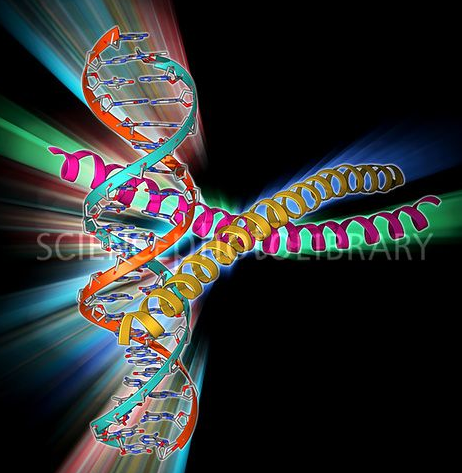Although crystal structures provide a great deal of information about the way that RNA polymerase initiates transcription, additional types of experimental information are required to explain how the active center in RNA polymerase moves during abortive initiation and how the system acquires the energy needed for RNA polymerase to escape the promoter.
Two experiments performed to examine how the active center moves during abortive transcription initiation appeared to provide contradictory observations. First, the observation that abortive initiation leads to the formation of RNA products up to-8-10 nucleotides in length suggests that the RNA polymerase active center moves relative to the DNA that it acts on. Yet in apparent contrast, DNA-footprinting experiments indicate that the enzyme does not move during abortive transcription because it protects the same up-stream DNA fragment before and after abortive RNA synthesis.
Three models have been offered to reconcile these seemingly contradictory observations. The scrunching model proposes that DNA is pulled into the RNA polymerase holoenzyme as the DNA unwinds to form the open complex. The energy stored in the scrunched DNA is then used for promoter escape. The inchworm model proposes that the leading edge of RNA polymerase advances during the early stage of transcription initiation to allow the active center to move forward, while the other end of the enzyme remains anchored to the upstream DNA region. The energy stored in the stretched protein is used for promoter escape. Finally, the transient excursion model proposes transient cycles of forward enzyme motion during abortive RNA synthesis and backward enzyme movement after abortive transcript release with long intervals between cycles. The long interval times between cycles was postulated to explain the footprinting observations.
Richard H. Ebright and coworkers performed two types of experiments to distinguish among the models. In the first, they attached pairs of fluorescent tags to specific sites on the RNA polymerase holoenzyme or DNA and then used fluorescence resonance energy transfer to monitor distances within single molecules of abortively initiating transcription initiation complexes. They observed that the RNA polymerase holoenzyme does not stretch to reach adjacent DNA segments (eliminating the inchworm model) and does not move to reach adjacent DNA segments. Instead, their observations indicated that the RNA polymerase holoenzyme remains stationary and pulls adjacent DNA into itself. In the second type of experiment, Ebright and coworkers monitored the end-to-end extension of a mechanically stretched, super-coiled, single DNA molecule. They demonstrated that RNA polymerase holoenzyme unwinds adjacent DNA segments and pulls the unwound DNA into itself during initial transcription ("scrunching") and then re-winds the unwound DNA when the RNA polymerase leaves the initiation site and begins to move down the DNA ("unscrunching"). Energy stored in the system during the scrunching stage is used during promoter escape to break interactions between the RNA polymerase holoenzyme and the initiation site and to allow RNA polymerase to move forward as the transcription elongation complex. We do not yet know how the scrunched DNA is organized in the RNA polymerase · promoter initial transcribing complex. However, it may be possible to obtain this information by subjecting the crystallized complex to x-ray diffraction analysis.








